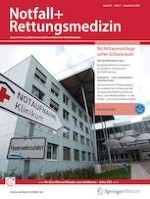18.09.2023 | Leitthema
Notfallsonographiekonzepte im nichttraumatologischen Schockraum – eFAST, FEEL, RUSH und andere
Erschienen in: Notfall + Rettungsmedizin | Ausgabe 7/2023
Einloggen, um Zugang zu erhaltenZusammenfassung
Die bettseitige Notfallsonographie gewinnt weltweit zunehmend an Stellenwert. Das Focused Assessment with Sonography for Trauma(FAST)-Protokoll zum Ausschluss freier intraabdomineller Flüssigkeit ist im traumatologischen Schockraum seit vielen Jahren etabliert. Zahlreiche Untersuchungsprotokolle sind für die Diagnostik beim nichttraumatologisch kritisch kranken Patienten im Einsatz. Dies wird von vielen Spezialisten der Organsonographie kontrovers diskutiert und mit mangelnder Untersuchungs- und Ausbildungsqualität und der Gefahr von Fehldiagnosen konnotiert. Nach unserer Kenntnis wurde bislang kein einheitliches Konzept für Zeitpunkt und Art des Einsatzes von Point-of-care-Ultraschall (POCUS) im nichttraumatologischen Schockraum entwickelt. Die Integration der Notfallsonographie in einen Algorithmus zur Versorgung nichttraumatologisch kritisch kranker Patienten könnte den Befürchtungen des ungezielten und unreflektierten Einsatzes entgegenwirken. Im vorliegenden Beitrag sollen Hintergründe, Kontroversen und aktuelle Entwicklungen der Notfallsonographie beleuchtet und die bekanntesten Point-of-care-Protokolle vorgestellt werden. Mit der Rapid Ultrasound for Shock and Hypotension(RUSH)-Sonographie nach Advanced Critical Illness Life Support (ACiLS) wird ein möglicher Weg aufgezeigt, wie POCUS den hohen Erwartungen der verschiedenen Stakeholder an die Notfallsonographie durch Integration in einen Versorgungsalgorithmus gerecht werden kann.
Anzeige














